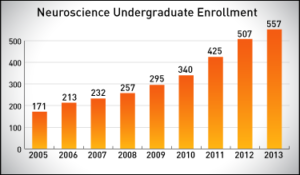UT Dallas Faculty and Students Lead the Way in Exploration of the Brain
By David E. Daniel, Ph.D.
In the early 1990s, the federal government launched a 15-year program to map the human genome, and in the process revolutionized the way researchers conducted science. The Human Genome Project required the collaborative work of biologists, engineers, computer scientists, clinicians and more. It involved a hefty investment of research funding that, by some estimates, returned $141 for every dollar spent.
Now, Washington’s research establishment has issued a new challenge to the scientific community — the BRAIN Initiative (Brain Research through Advancing Innovative Neurotechnologies). This bold idea — that we can develop ways to provide a real-time view of the working brain — is of great interest here at UT Dallas, which has long been dedicated to discovering the brain’s inner workings.
 Last year alone, the National Institutes of Health awarded 14 UT Dallas faculty members a total of 23 new grants to research the brain. These projects are spread across the School of Behavioral and Brain Sciences, the School of Natural Sciences and Mathematics, and the Erik Jonsson School of Engineering and Computer Science.
Last year alone, the National Institutes of Health awarded 14 UT Dallas faculty members a total of 23 new grants to research the brain. These projects are spread across the School of Behavioral and Brain Sciences, the School of Natural Sciences and Mathematics, and the Erik Jonsson School of Engineering and Computer Science.
These federal grants support research that will help our scientists and engineers better understand anxiety disorders, post-traumatic stress, aging of the brain and autism. They support efforts to develop new methods for delivering molecules across the blood-brain barrier.
Researchers here realized long ago that advancement was likely to come faster if experts across an array of academic specialties worked together, as reflected in the varied missions of the Center for BrainHealth, the Center for Vital Longevity, the Texas Biomedical Device Center and the Department of Bioengineering, as well as in partnerships among researchers at UT Southwestern Medical Center, UT Arlington and UT Dallas.
These researchers not only focus on their own quest for knowledge but also pay keen attention to training future generations of neuroscientists. Our undergraduate neuroscience program is still relatively young, first enrolling students in 1996. Enrollment has more than tripled in the past eight years. Our master’s program in applied cognition and neuroscience and the doctoral program in cognition and neuroscience have both steadily increased in size.
Grants from the NIH and other sources support faculty inquiry, and also bring students into the lab to gain hands-on research experiences. For example, Drs. Christa McIntyre-Rodriguez and Sven Kroener were awarded a grant with a provision that undergraduate students be trained as researchers to investigate the mechanisms behind anxiety disorders. Upwards of 30 undergraduate volunteers spend time in our larger neuroscience research labs. More than 80 are involved in work in the Texas Biomedical Device Center, according to a report given recently by the center’s director, Dr. Rob Rennaker. The valuable experience these budding researchers gain can provide a major advantage when applying to top graduate schools.
It remains to be seen what will be discovered through the nascent BRAIN Initiative and where those discoveries will lead. But we expect that within this generation of scientists and researchers working on the project there will be a significant number of important connections and discoveries here at UT Dallas, where we focus on creating the future.
 David E. Daniel, Ph.D., is president of UT Dallas. He is a member of the National Academy of Engineering and past president of TAMEST.
David E. Daniel, Ph.D., is president of UT Dallas. He is a member of the National Academy of Engineering and past president of TAMEST.

